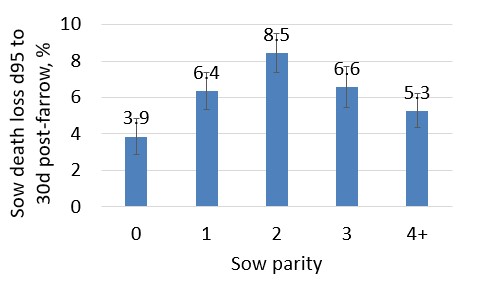Sow Death Loss Associated With Parity, Sow Body Condition
go.ncsu.edu/readext?912994
en Español / em Português
El inglés es el idioma de control de esta página. En la medida en que haya algún conflicto entre la traducción al inglés y la traducción, el inglés prevalece.
Al hacer clic en el enlace de traducción se activa un servicio de traducción gratuito para convertir la página al español. Al igual que con cualquier traducción por Internet, la conversión no es sensible al contexto y puede que no traduzca el texto en su significado original. NC State Extension no garantiza la exactitud del texto traducido. Por favor, tenga en cuenta que algunas aplicaciones y/o servicios pueden no funcionar como se espera cuando se traducen.
Português
Inglês é o idioma de controle desta página. Na medida que haja algum conflito entre o texto original em Inglês e a tradução, o Inglês prevalece.
Ao clicar no link de tradução, um serviço gratuito de tradução será ativado para converter a página para o Português. Como em qualquer tradução pela internet, a conversão não é sensivel ao contexto e pode não ocorrer a tradução para o significado orginal. O serviço de Extensão da Carolina do Norte (NC State Extension) não garante a exatidão do texto traduzido. Por favor, observe que algumas funções ou serviços podem não funcionar como esperado após a tradução.
English
English is the controlling language of this page. To the extent there is any conflict between the English text and the translation, English controls.
Clicking on the translation link activates a free translation service to convert the page to Spanish. As with any Internet translation, the conversion is not context-sensitive and may not translate the text to its original meaning. NC State Extension does not guarantee the accuracy of the translated text. Please note that some applications and/or services may not function as expected when translated.
Collapse ▲Sow Death Loss Associated with
Parity, Sow Body Condition
Mark Knauer
North Carolina State University
Sow death loss continues to challenge pig farmers. Hence, further characterization of the problem may be helpful toward finding solutions.
Our group characterized sow mortality at a 2600 head commercial sow farm in eastern North Carolina over a 27-week period. Sows were housed in individual stalls during gestation. Therefore, there was limited competition between sows during feeding. Sow mortality was specifically evaluated between day 95 of gestation and 30 days post-farrowing. Females were evaluated at day 95 of gestation for body condition using the Knauer sow body condition caliper (<12 = “BCS 2”, 12 to 15 = “BCS 3”, 16 to 18 = “BCS 4”, >18 = “BCS 5”). Farm recorded sow mortality codes included difficult farrow (7%), lameness (32%), prolapse (21%) and unknown (40%). Of the 3,340 sows evaluated, 190 (5.7%) died between day 95 of gestation and 30 days post-farrow.
Sow mortality was statistically associated (P<0.05) with parity (Figure 1). First litter females were more likely to survive relative to older parity sows.

Figure 1. Relationship between sow parity and sow death loss from day 95 of gestation to 30 days post-farrow.
Figure 2 shows the relationship between sow mortality and sow body condition. Heavier conditioned sows were more likely (P<0.05) to survive. Associations between farm recorded mortality codes with the sow body condition caliper are shown in Figure 3.

Figure 2. Association between sow body condition score (BCS) and sow death loss from day 95 of gestation to 30 days post-farrow.

Figure 3. Association between sow body condition (Knauer sow caliper score) and sow death loss category. A one-unit change in sow caliper score equates to approximately 1/3 of a body condition score when using a 1 to 5 BCS scale.
Sows that prolapsed were statistically thinner (P<0.05) than sows that lived, sows that were euthanized for lameness, or those that died for unknown reasons (caliper scores 15.1 vs. 16.1, 15.9 and 15.9, respectively). A one-unit change in sow caliper score equates to approximately 1/3 of a body condition score when using a 1 to 5 BCS scale. Hence, on a 1 to 5 BCS scale, sows that prolapsed were approximately 1/3 of a body condition score thinner than sows that lived.
Does this data support increasing herd body condition from “ideal” to “fat” to enhance sow survival? Perhaps not. Our statistical model showed parity and sow body condition together explained a very small amount of the variation (less than 2%) in sow death loss. Hence, it may be wise to focus on factors that have a greater relationship with sow death loss. Questions can be sent to Mark Knauer at mtknauer@gmail.com.


